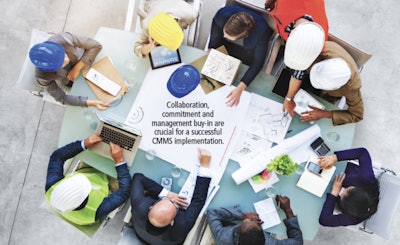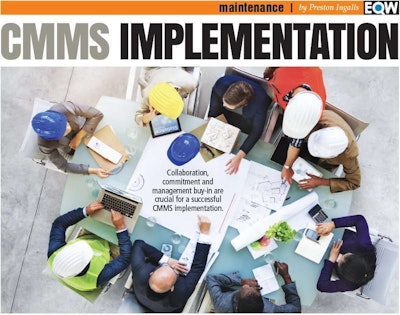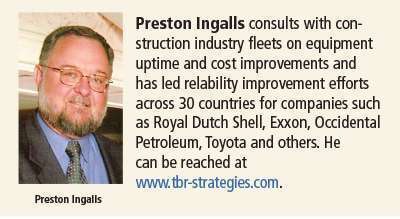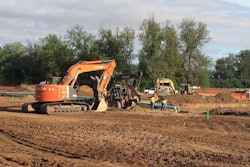

You bought it. Now you have to make it work. Here’s a 14-point plan to bring your maintenance-management protocols into the digital age.
Earlier this year, we looked at how to evaluate and choose a computerized maintenance management system (CMMS). But that’s just half the battle. Implementing the system is equally as important. A weak effort here could bring disappointing returns on the investment, confusion in the ranks and egg on your face. By following the 14-step process below, you can have a successful implementation and reap the many rewards. But you don’t just flip a switch. A typical CMMS implementation for a construction or construction materials company takes six to 12 months.
Step 1: Develop goals and objectives
It’s important to first develop the short and long term goals of what you hope to accomplish with the CMMS, such as inventory control, maintenance labor and material cost tracking, generating PMs, and planning and scheduling maintenance activities.
It’s also vital to determine how the CMMS system will interface with your enterprise resource systems or accounting system. The integration of your CMMS and back office systems will necessitate answering the following questions:
• How soon does that need to happen?
• Did you intend to use tablets or smartphones and how soon does this need to happen?
• Did you want your CMMS to generate and track purchase orders, and if so, how soon?
Step 2: Determine resource needs
Form an implementation team and appoint a project manager. The project manager must commit the majority of his or her time to the effort – you can’t just add it to their existing responsibilities. Make sure they are knowledgeable about maintenance processes, which can be a common failure point with many implementation projects.
One of the first steps the team should take is to determine how much manpower you need to gather the information on the assets entered into the system. Are your assets currently identified and labeled with a unique identifier or asset number? If not, additional time will be needed to inventory and mark physical assets.
Consider using an outside resource such as an implementation consultant who can reduce the learning curve and get this done sooner
Step 3: Involve management
Management should be educated as to the purpose, return on investment, benefits, costs and resources needed to successfully complete implementation. If they don’t understand the necessity of those resources, they will be frugal and overly selective. Be candid with the commitments you need for people, time and hardware. If you don’t ask for it, you won’t get it.
Consider sending several articles on CMMS implementation (and failures) as a pre-read before meeting with management. Some good sources for articles are reliabilityweb.com and maintenanceresources.com.
Step 4: Develop the plan
All CMMS software publishers have a project implementation template they use, often in the form of a Gantt Chart like the one below. The plan should be fairly detailed with start and stop dates and resources assigned, so it requires answers to the following questions:
• Is there a critical path?
• Are there key milestones that must be met?
• What are the work order priorities, types and status codes that need to be identified?
You will need to delegate who will be responsible for each activity and create a suitable timeframe for completion. Follow up to ensure that those responsible for activities understand how to complete their tasks and have the resources to accomplish them.
Share the plan with all team members. Make sure the work gets done – not just assigned. There are a few good quality project management software solutions available. For example, google the list PC Magazine published on January 5th, “The Best Project Management Software of 2017.”
Step 5: Develop structures and schemes
At this point, it is important to determine how things such as parts will be numbered and referred to in inventory control and bills of materials, and have a uniform way to refer to assets. This means selecting a numbering and naming convention.
Will you use a company part numbering system over the vendor’s part numbering (highly recommended)? Will the numbers be intelligent or significant? This means the numbering scheme will provide information about the part itself.
An example of an intelligent naming and numbering system would be to use something like RES100-2342, where RES stands for resistor, the first three numbers indicate the ohms and the last four are serial numbers. Although it takes time to set up an intelligent or significant numbering convention, it will save time and improve accuracy later.
This is also the time to agree on problem-cause-remedy failure codes. PCR failure codes need to be agreed upon as most CMMS failure codes are too generic and not equipment or industry specific. This way, analysis of failures can be sorted more efficiently later.
Step 6: Confirm assets
You will be surprised how many asset lists are out-of-date and inaccurate. A good step here is to do a physical inventory of all assets at all locations. This is best performed on weekends when work is least likely to disrupt the activity.
Make sure every asset has a unique identifier or asset number, including trailers, light towers, portable compressors and other small equipment types. The physical inventory should result in “hands and eyes” on every piece of company equipment. Shop assets (like motors above a certain horsepower rating), pumps and compressors need to have an asset number assigned if they are repairable or recoverable.
One of the values of a good CMMS is the ability to drill down for specific information, but you can only do that if you have enough detail.
Step 7: Use the management of change
Implementing a CMMS will involve a change to the culture. You may be introducing computerized information management to folks who are computer illiterate or more comfortable with manual paperwork.
Changes may be seen as threats by some. Our best advice: communicate, communicate, communicate. The more awareness people have about the what, why, and when, the less of a threat it appears.
An effective format for educating and communicating change is called the management of change or the MOC 6-step communications format. The MOC 6-steps are:
1. Define the opportunity: Explain the rationale for the change.
2. Define the direction ahead: Explain in general terms what and why the change is occurring and what the end state looks like.
3. What is unchanged: Explain what remains the same.
4. What is changing: Explain what specifically will be changing or different.
5. Define commitments and next steps: Explain management’s backing and immediate next steps.
6. Contacts: Explain who to contact for additional information on the changes.
Step 8: Gather data
One of the important tasks is transferring data from the old system. In some cases, the information may be so inaccurate that starting from scratch may be the best option. Another alternative is to transfer it via a spreadsheet formatted to accommodate the new system.
Data migration is important and should be screened for inaccuracies prior to migration. This is called data scrubbing. Think of this as a quality control step. The equipment register will need to be populated with equipment specifics like:
Step 9: Data migration
Data entry is a tedious but important step. Who will do this job? It is not advisable that it be done by the project manager because of the time to perform it. Consider outside contractors, current employees or temporary hires. The good news is most of this is a one-time assignment.
Next, you need to determine the best person to enter the necessary day-to-day information that the CMMS will manage. Will it be a planner/scheduler or an admin?
Step 10: Develop work flows and PDFs
Many organizations make a mistake in automating inefficient and broken systems. Because their business processes never change, this approach simply automates existing difficulties and issues so that they occur faster than before.
A recommended process is to redesign practices, processes and procedures. This is called re-engineering or business process re-engineering. Process mapping is done using process flow diagramming to study current process flows. These start out being ‘as-is’ maps that include the problems associated with them, and are then recast by mapping out an ideal or a ‘should be’ model.
Once the new system is designed, an equipment build or CMMS process guide that includes coding and naming conventions and other formats can be developed. This method would also involve a PM process guide.
You would want a spares process guide that includes item naming conventions, abbreviations, how to deal with manufacturer’s part numbers. The MOC 6-step format can be used to inform people of the changes and training provided to show how to perform the new procedures.
Step 11: Create reporting process
One of the key purposes of a good CMMS is the reporting capabilities. Otherwise, you can be “data rich and information poor.” Most decent CMMS programs come with a set of stock reports. Some should be generated automatically while others are upon request. The important point here is the reports should provide information to monitor progress and identify areas that need attention.
Another feature is the ability to create custom or ad-hoc reports. Quality programs allow custom report generation with little effort. Some of the articles posted on reliabilityweb.com explain common reports, but the following questions should be answered at the start of the template generation process:
• Who will receive regularly scheduled reports?
• How often will you issue those reports?
• Which reports are the most critical to your organization for decision making?
Thinking about reports ahead of time will help ensure that the system is configured and used in a way that will get you the information you need. Decisions are made with reliable and prompt information
Step 12: Training
Because of the complexities of the CMMS, training is required. This is one of the largest failure points leading to CMMS implementation disasters – underestimating training needs.
All CMMS vendors provide training in many forms ranging from onsite to online. Vendor training will allow more accuracy via their ability to answer questions and provide examples in real-time.
Training is not an area where you can skimp. Consider how new employees will be trained and use the MOC 6-step format to help with education. Training needs to be hands-on at a computer.
Step 13: Audit. Audit. Audit.
Set-up a PM for monthly and quarterly data integrity reviews. You need to be vigilant in looking for weaknesses in CMMS data integrity. Otherwise the system will appear weak and inefficient. Remember “garbage in-garbage out.” Standard operating procedures lists or process guides need to be developed to ensure data consistency and integrity.
Inspect what you expect. Routinely look for input errors, omissions, poor failure coding, inefficient naming conventions, improper structure and poorly generated PMs to prevent problems.
Step 14: Continuous improvement
Protect and maximize your investment by constantly reviewing what works and what doesn’t. Use debriefing sessions to find out what needs to be improved. Don’t be afraid to visit a company your software vendor told you is optimizing its CMMS program. Use them as a benchmark. To become the best, you study the best.
Periodically conduct surveys to find out what is and isn’t working. Be open to critiques and respond to them. Practice intellectual curiosity by reading some of the resources mentioned here.
Editor’s note: CMMS processes for asphalt and concrete plants often follow a similar path to what’s described above, but with additional provisions and complexity. If you would like to learn more about how to implement CMMS for plants, get in touch with Preston Ingalls. You’ll find his contact information below.















